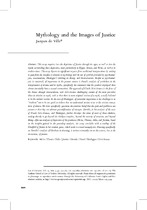| dc.description.abstract | This essay enquires into the depictions of Justice through the ages, as well as the myths surrounding these depictions, more particularly in Egypt, Greece, and Rome, as well as in modern times. The essay departs in significant respects from traditional interpretations by seeking to gain from the insights in relation to mythology and the use of symbols provided by psychoanalysis, structuralism, Heidegger’s thinking on Being, and deconstruction. Insofar as psychoanalysis is concerned, of importance in the present context is Freud’s analysis of symbolism in the interpretation of dreams and in myths, specifically insofar as he contends that the symbols employed there almost invariably have a sexual connotation. The approach of Claude Lévi-Strauss is the focus of the detour through structuralism, with Lévi-Strauss challenging certain of the most prevalent ideas in relation to myth, such as that there is some original version of a myth, usually believed to be the earliest version. In the case of Heidegger, of particular importance is his challenge to us “moderns” to not be too quick in our belief that we understand ancient texts or the ancient conceptions of deities. He more specifically places in question the common belief that the gods and goddesses are persons or that they are abstract personifications of concepts. Derrida, in his analysis of the texts of Freud, Lévi-Strauss and Heidegger, further develops the ideas of each of these thinkers, seeking thereby to go beyond the Oedipus complex, beyond the security of structure, and beyond Being. After an analysis of depictions of the goddesses Ma’at, Themis, Dike and Justitia, based on the insights gained in the preceding analysis, the essay concludes with a reading of the blindfold of Justice in her modern guise which seeks to exceed metaphysics. Drawing specifically on Derrida’s analysis of blindness in drawing, it arrives eventually not at the essence, but the an-essence of justice. | en_US |

